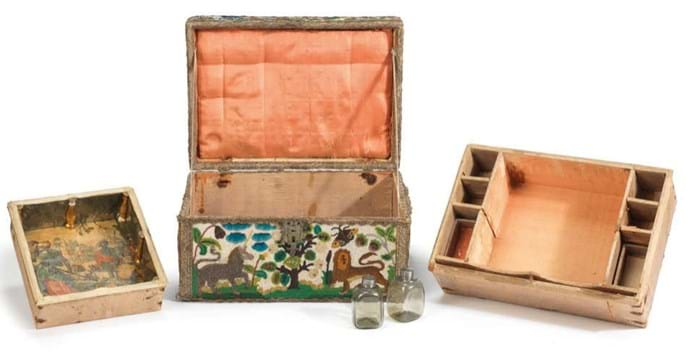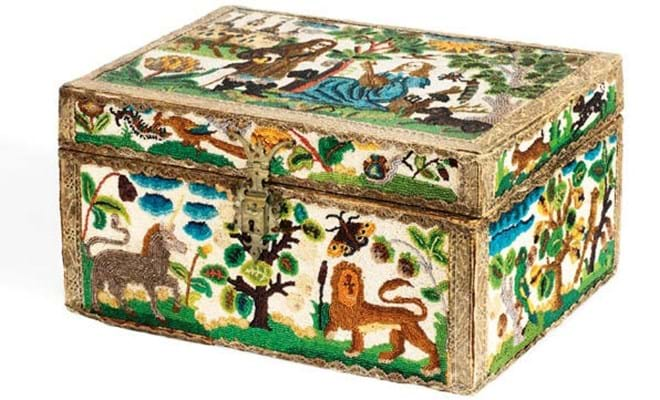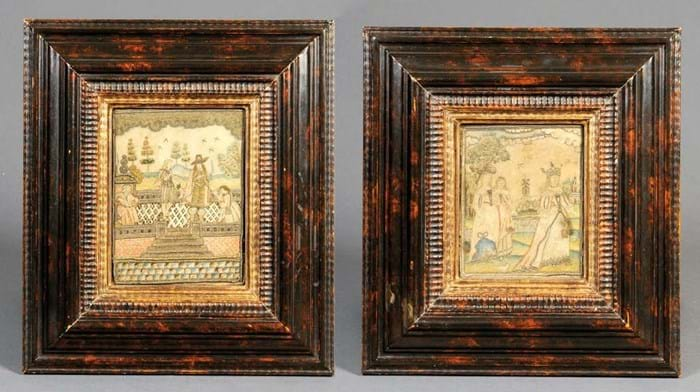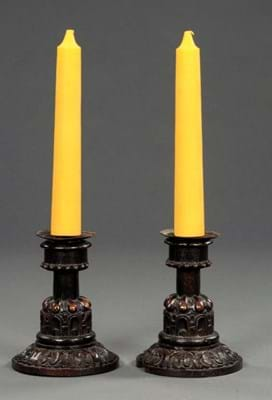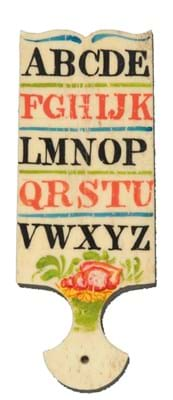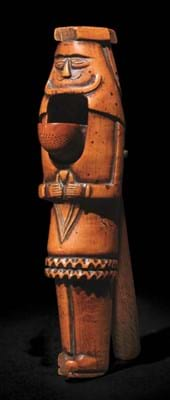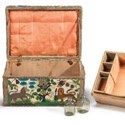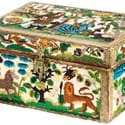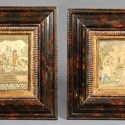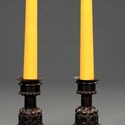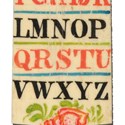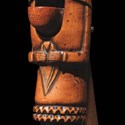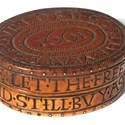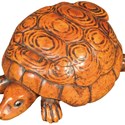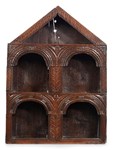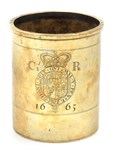The 13in (33cm) box offered at Bonhams was bound in silver thread braid with mainly blue, green, brown and white beads to form a typical design of a courting couple, flora and fauna. The pink silk and paper lined interior had compartments for bottles (two present), a mirrored-glass tray and hidden drawers.
It included a receipt from Trevor Micklem Antiques in Tiverton dated June 22, 1978, for £1900. Here, estimated at £7000-10,000, it sold at £13,000.
A comparable box, from the Irvin and Anita Schorsch collection, sold at Sotheby’s New York in January 2016 for $15,000. Another dome-lidded example from the Simon Sainsbury Collection sold at Christie’s in June 2008 for £10,000.
A Charles II beadwork basket, also c.1660 (but with some later additions to the handles and the stand) sold at £6000. The design – probably after patterns printed by Peter Stent (fl.1613-65) – is similar to another in the Victoria and Albert Museum set with the maker or recipient’s name: Sarah Gvrnall Avgust 24 Anno 1659.
Doubtless the matched pair of 17th century embroidered ‘stumpwork’ pictures sold by Mitchells (20% buyer’s premium) of Cockermouth on March 9 would also once have shared the same vibrant colours.
Today the small embroideries depicting Charles II with courtiers in exile, measuring 9 x 6½in (22 x 17cm), and Queen Catherine with attendants, 7 x 6in (18 x 14cm), were somewhat faded although otherwise they were in fine condition. They sold in original mock tortoiseshell moulded frames for £3400.
Treen
A diminutive 2½in (7cm) Charles II snuff box offered at Bonhams with hopes of £1500-2000 had everything one might hope for in a piece of treen. Part of the well-received Golding-Barrett collection, bidding kept going to £6000.
Fashioned in boxwood and horn with tiny brass nails, arranged around its oval form and the date 1661, were the words The Yeare of Our Lord God, and to the sides Let The Free Man Come Fill But Let the Close Man Stand Still As Wel As I.
The base was centred by the date 1610 and engraved Francis Clarke His Age July 8. This could well relate to a Francis Clarke who (together with twin brother George) was baptised in Othery, Somerset, on July 8, 1610.
The same parish register records the marriage of his father John Clarke to Joanne Avoks on May 10, 1596.
A collection of lever-action nutcrackers included some very fine examples from the late Stuart and early Georgian period. David Houlson of Bonhams described this as “strong niche area”.
Sold at £5500 was a finely patinated early 18th century boxwood nutcracker from northern Europe modelled as the figure of a man with the scratch date 1730.
It was previously in the treen collections of Anthony Tabor and Owen Evan-Thomas (when the date was erroneously thought to be 1780).
A companion nutcracker thought to be made by the same hand, carved as a woman holding open her womb to reveal a child was part of the collection of Jonathan Levi, author of the 1998 book Treen for the Table.
When the Levi collection was sold at CSK in November 2006 (a month, incidentally, when CSK held 33 sales), it was described as ‘Low Countries c.1700’ and took £1600.
A 9in (23cm) gilt and polychrome nutcracker modelled as a soldier wearing a plumed hat and armour was thought to be German. It is related to another carved as a Turk which sold at CSK in September 2010 for £1000. The date is a matter of some conjecture (it was catalogued as ‘18th century but possibly earlier’) but the price was a strong £4200.
An English or French boxwood lever-action nutcracker carved with the face of a wide-eyed man, 15cm high, from the Hopwell collection sold at £5200. A similarly fashioned nutcracker, dated c.1670 and described as English, is illustrated in Treen for the Table.
Some fine examples of treen formed part of the connoisseur collection of Stuart and Georgian objects sold by Mitchells (20% buyer’s premium) on March 9.
Owned by a deceased Cumbrian collector, many were sold with 1980s and ’90s purchase receipts for well-known dealers such as Alistair Sampson, Rupert Gentle, Rogers De Rin and Robin Butler.
Auctioneer Mark Wise described it as “one of the finest and most historically interesting collections we have sold to date”. All these items received largely modest printed expectations of the ‘here-to-sell’ type. A purchase from Alistair Sampson at a punchy £1100 in 1987 was an 18th century fruitwood snuffbox carved as a tortoise with a tortoiseshell interior and glass eyes. Here it sold at £2600.
Also bought from Sampson was a 4in (10cm) bone tablet or hornbook painted with the alphabet and a spray of flowers.
Hornbooks (Names for Things – see book review right – says they were also known as battledores) were originally made by pasting a paper copy of the alphabet or a prayer on a piece of wood, which was then covered with a thin sheet of transparent horn for protection.
They are also known in brass, lead, pewter, silver, bone or even gingerbread. Examples in ivory are rare. Another with an engraved alphabet sold for £950 at Cheffins in Cambridge in March 2015. This one, with charm to spare, doubled expectations at £1400, selling to a north of England private buyer.
Few who viewed could have expected to purchase a pair of Elizabethan oak candlesticks at close to the £250-300 estimate.
Standing 11½in (29cm) high and carved with gadrooning and foliage, they had suffered some losses and replacements (the detachable drip trays were old but not original) but were essentially c.1580. Back in 1980 the pair had retailed for £1050.
The winning bid of £8000 came from a north of England private buyer vying with a Somerset dealer who coveted them for his own collection.


